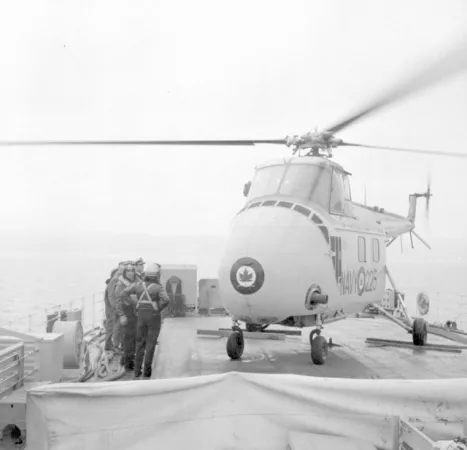
Highlights:
- American-built helicopter used during the 1950s and 1960s for various purposes, including civilian and military transportation
- Flown by the military and naval forces of thirty-six countries, including the RCAF and RCN
- Used to test an idea that led to the "Beartrap", a highly innovative Canadian device still used today to safely land helicopters on small warships
- Became the first certified transport helicopter, the first helicopter to fly across the Atlantic Ocean, and the first helicopter to be equipped with anti-submarine sonar and torpedoes
- First flight was on November 10, 1949
Image Gallery:
History:
The S-55 was the first helicopter with both the space and power to carry large loads. It was in heavy demand by both civil and military operators. Okanagan Helicopters operated 21 S-55s while the RCAF flew 15 transport versions and the RCN operated 13 HO4S-3. A total of 1 100 were built in the United States and a further 550 in other countries. The HO4S-3 retired from Canadian service in 1970.
The S-55 was the world’s first certified transport helicopter, the first helicopter to fly the Atlantic, and the first equipped with anti-submarine sonar and torpedoes. The HO4S-3 was used by the RCN to test an idea that led, after several years of research, to the development of the "Beartrap" equipment which allowed helicopters to operate from small warships in the open ocean.
Current Location:
Helicopters Exhibition, Canada Aviation and Space Museum
Provenance:
Donated by CAF
Built in 1955, this S-55, known as "Shearwater Angel," served the RCN for fifteen years until 1970, when it was retired and donated to the Museum. It participated in eight rescue missions and was credited with rescuing thirty-two people and four animals over its lifetime. Eight maple leaves decorate the nose of the helicopter, one for each rescue mission.
Its most famous mission was its rescue of twenty-one crew members of the Liberian freighter Kismet II, along with the ship's dog and cat, which took place on November 26, 1955 off the coast of Cape Breton Island.
Technical Information:
| Rotor diameter: | 16.2 m (53 ft) |
| Length | 12.9 m (42 ft 2 in) |
| Height | 4.5 m (14 ft 8 in) |
| Weight, Empty | 2,380 kg (5,250 lb) |
| Weight, Gross | 3,420 kg (7,540 lb) |
| Cruising Speed | 148 km/h (91 mph) |
| Max Speed | 180 km/h (112 mph) |
| Rate of Climb | 311 m (1,200 ft) /min |
| Service Ceiling | 3,231 m (10,600 ft) |
| Range | 570 km (360 mi) |
| Power Plant | one Wright R-1300-3D Cyclone 7, 600 hp radial engine |
- View all the collection highlights at the Canada Aviation and Space Museum
- View other collection highlights related to Aviation



